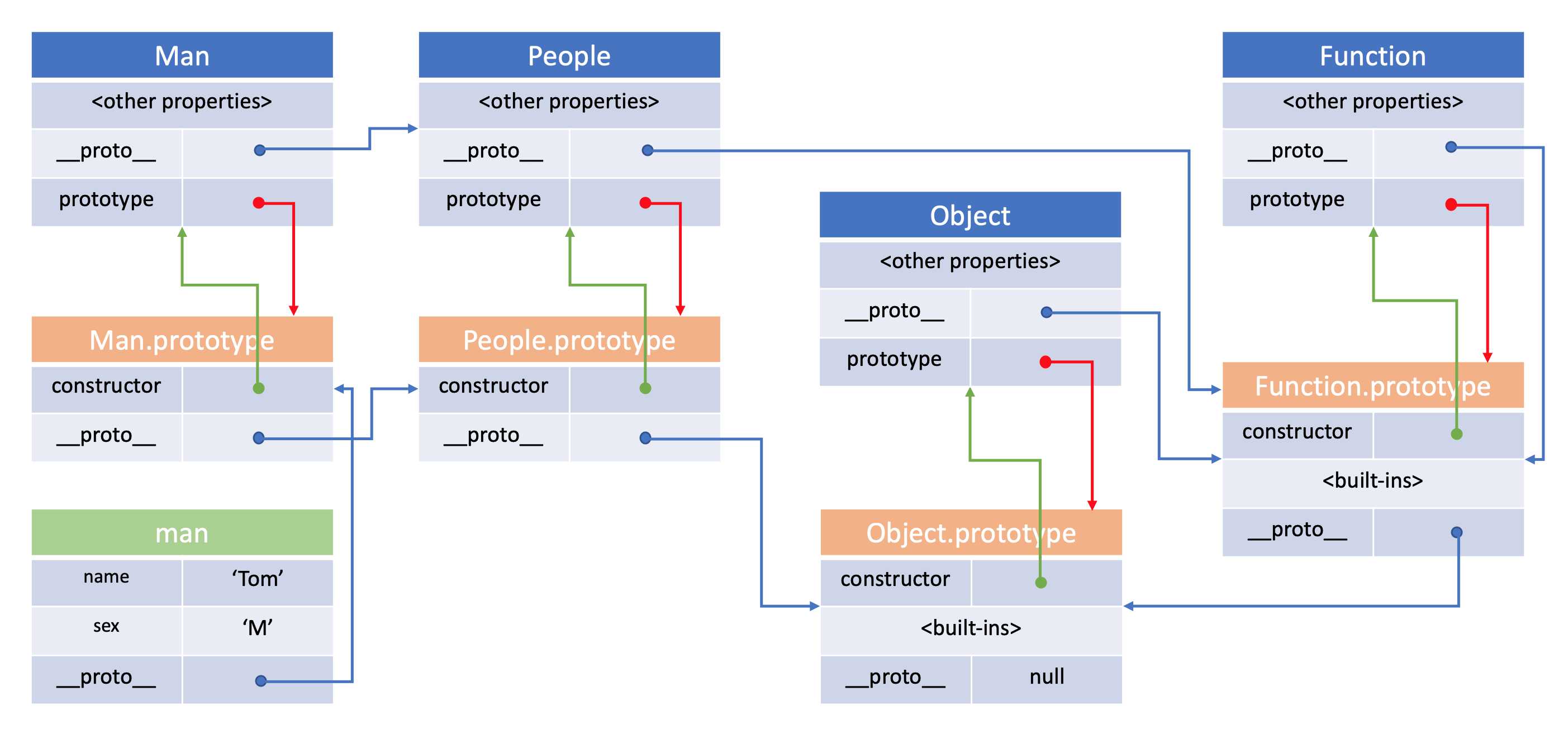深入理解JS中的对象(三):class 的工作原理
2021-02-21 01:19
标签:init 修改 直接 es2015 name 类的继承 工作 变量 super 目录 1.序言 ECMAScript 2015(ES6) 中引入的 JavaScript 类实质上是 JavaScript 现有的基于原型的继承的语法糖。类语法(class)不会为JavaScript引入新的面向对象的继承模型。 2.class 是一个特殊的函数 ES6 的 class 主要提供了更多方便的语法去创建老式的构造器函数。我们可以通过 typeof 得到其类型: 那 class 声明的类到底是一个什么样的函数呢?我们可以通过在线工具 ES6 to ES5 来分析 class 背后真正的实现。 3.class 的工作原理 下面通过多组代码对比,来解析 class 声明的类将转化成什么样的函数。 第一组:用 class 声明一个空类 ES6的语法: 这里提出两个问题: 1.class 声明的类与函数声明不一样,不会提升(即使用必须在声明之后),这是为什么? 在浏览器中运行报错,如下图: 2.不能直接像函数调用一样调用类 在浏览器中运行报错,如下图: 转化为ES5: 针对上面提到的两个问题,我们都可以用转化后的 ES5 代码来解答: 对于问题1,我们可以看到 class 声明的类转化为的是一个函数表达式,并且用变量 People 保存函数表达式的值,而函数表达式只能在代码执行阶段创建而且不存在于变量对象中,所以如果在 class 声明类之前使用,就相当于在给变量 People 赋值之前使用,此时使用是没有意义的,因为其值为 undefined,直接使用反而会报错。所以 ES6 就规定了在类声明之前访问类会抛出 ReferenceError 错误(类没有定义)。 对于问题2,我们可以看到 People 函数表达式中,执行了 _classCallCheck 函数,其作用就是保证 People 函数必须通过 new 调用。如果直接调用 People(),由于是严格模式下执行,此时的 this 为 undefined,调用 _instanceof 函数检查继承关系其返回值必然为 false,所以必然会抛出 TypeError 错误。 补充:类声明和类表达式的主体都执行在严格模式下。比如,构造函数,静态方法,原型方法,getter和setter都在严格模式下执行。 第二组:给类添加公共字段和私有字段 ES6的语法: 转化为ES5: 对比转化前后的代码可以看出: 对于私有字段,在使用 class 声明私有字段时,约定是以字符 ‘#‘ 为开头,转化后则将标识符中的 ‘#‘ 替换为 ‘_‘,并且单独用一个 WeakMap 类型的变量来替代类的私有字段,声明在函数表达式后面(也会自动检查命名冲突),这样就保证了类的实例对象无法直接通过属性访问到私有字段(私有字段根本就没有在实例对象的属性中)。 对于公共字段,则是通过 _defineProperty 函数将类的公共字段映射为实例对象的属性,如果是首次设置,还会通过 Object.defineProperty 函数来进行初始化,设置属性的可枚举性(enumerable)、可配置性(configurable)、可写性(writable) 第三组:给类添加构造函数与实例属性 ES6的语法: 转化为ES5: 对比转化前后的代码可以看出: 类的构造函数(constructor)里面的代码的执行时机是在字段定义(字段映射为实例对象的属性)之后。而对私有字段的赋值(修改)是专门通过 _classPrivateFieldSet 函数来实现的。 第四组:给类添加原型方法和静态方法 ES6的语法: 转化为ES5: 对比一下第三组和第四组转化后的代码,可以明显发现: 类的字段通过 _defineProperty 函数映射到实例对象(this)的属性上。 类的方法则通过 _createClass 函数映射到构造函数的原型(Constructor.prototype)的属性上, 类的静态方也通过 _createClass 函数映射到构造函数(Constructor)的属性上。 第五组:类的继承 ES6的语法: 转化为ES5: 在 _inherits 函数中,实现了原型链和静态属性的继承: 1.通过 (1) (2) 2.通过调用 (1) 在 Man 构造函数中,通过调用其父类的构造函数(_super),实现了子类的 this 继承父类的 this 上的属性: 从上述可知 class 继承的实现主要包含三部分: 4.class 继承的原型链关系 实例代码: 根据上面分析所知道的类(class)的继承的实现原理,并结合 深入理解JS中的对象(一):原型、原型链和构造函数 中所提到的构造函数的原型链关系,可得示例代码的完整原型链关系如下图: 5.参考 类- JavaScript | MDN exploring-es6 - class 为什么说ES6的class是语法糖? 深入理解JavaScript系列(15):函数(Functions) class继承做了什么呢? 深入理解JS中的对象(三):class 的工作原理 标签:init 修改 直接 es2015 name 类的继承 工作 变量 super 原文地址:https://www.cnblogs.com/forcheng/p/12913103.html
class People {
constructor(name) {
this.name = name;
}
}
console.log(typeof People) // function
class People {}
console.log(People) // ReferenceError
class People {}

People(),必须通过 new 调用类,如 new People(),这又是为什么?class People {}
People() // TypeError

"use strict";
function _instanceof(left, right) {
if (right != null && typeof Symbol !== "undefined" && right[Symbol.hasInstance]) {
return !!right[Symbol.hasInstance](left);
} else {
return left instanceof right;
}
}
// 判断 Constructor.prototype 是否出现在 instance 实例对象的原型链上
function _classCallCheck(instance, Constructor) {
if (!_instanceof(instance, Constructor)) {
throw new TypeError("Cannot call a class as a function");
}
}
var People = function People() {
// 检查是否通过 new 调用
_classCallCheck(this, People);
};
class People {
#id = 1 // 私有字段,约定以单个的`#`字符为开头
name = ‘Tom‘ // 公共字段
}
...
// 将类的公共字段映射为实例对象的属性
function _defineProperty(obj, key, value) {
if (key in obj) {
Object.defineProperty(obj, key, { value: value, enumerable: true, configurable: true, writable: true });
} else {
obj[key] = value;
}
return obj;
}
var People = function People() {
_classCallCheck(this, People);
// 初始化私有字段
_id.set(this, {
writable: true,
value: 1
});
// 将类的公共字段映射为实例对象的属性
_defineProperty(this, "name", ‘Tom‘);
};
// 转化后的私有字段(会自动检查命名冲突)
var _id = new WeakMap();
class People {
#id = 1 // 私有字段,约定以单个的`#`字符为开头
name = ‘Tom‘ // 公共字段
constructor(id, name, age) {
this.#id = id
this.name = name
this.age = age // 实例属性 age
}
}
...
// 设置(修改)类的私有字段
function _classPrivateFieldSet(receiver, privateMap, value) {
var descriptor = privateMap.get(receiver);
if (!descriptor) {
throw new TypeError("attempted to set private field on non-instance");
}
if (descriptor.set) {
descriptor.set.call(receiver, value);
} else {
if (!descriptor.writable) {
throw new TypeError("attempted to set read only private field");
}
descriptor.value = value;
}
return value;
}
var People = function People(id, name, age) {
_classCallCheck(this, People);
_id.set(this, {
writable: true,
value: 1
});
_defineProperty(this, "name", ‘Tom‘);
// constructor 从这开始执行
_classPrivateFieldSet(this, _id, id);
this.name = name;
this.age = age;
};
var _id = new WeakMap();
class People {
#id = 1
name = ‘Tom‘
constructor(id, name, age) {
this.#id = id
this.name = name
this.age = age
}
// 原型方法
getName() { return this.name }
// 静态方法
static sayHello() { console.log(‘hello‘) }
}
...
// 设置对象的属性
function _defineProperties(target, props) {
for (var i = 0; i
// 父类(superClass)
class People {}
// 子类(subClass)继承父类
class Man extends People {}
...
var People = function People() {
_classCallCheck(this, People);
};
var Man = function (_People) {
// Man 继承 _People
_inherits(Man, _People);
// 获取 Man 的父类的构造函数
var _super = _createSuper(Man);
function Man() {
_classCallCheck(this, Man);
// 实现了父类构造函数的调用, 子类的 this 继承父类的 this 上的属性
return _super.apply(this, arguments);
}
return Man;
}(People);
// 实现继承关系
function _inherits(subClass, superClass) {
if (typeof superClass !== "function" && superClass !== null) { throw new TypeError("Super expression must either be null or a function"); }
// Object.create(proto, propertiesObject) 方法
// 创建一个新对象,使用 proto 来提供新创建的对象的__proto__
// 将 propertiesObject 的属性添加到新创建对象的不可枚举(默认)属性(即其自身定义的属性,而不是其原型链上的枚举属性)
subClass.prototype = Object.create(superClass && superClass.prototype, { constructor: { value: subClass, writable: true, configurable: true } });
if (superClass) _setPrototypeOf(subClass, superClass);
}
// 设置对象 o 的原型(即 __proto__ 属性)为 p
function _setPrototypeOf(o, p) {
_setPrototypeOf = Object.setPrototypeOf || function _setPrototypeOf(o, p) { o.__proto__ = p; return o; };
return _setPrototypeOf(o, p);
}
Object.create 函数调用可知:subClass.prototype.__proto__ === superClass.prototype ,相当于实现了原型链的继承subClass.prototype.constructor === subClass ,表明 subClass 构造函数的显示原型对象(prototype)的 constructor 属性指向原构造函数_setPrototypeOf(subClass, superClass)可知:subClass.__proto__ === superClass,相当于实现了静态属性的继承// 获得父类的构造函数
function _createSuper(Derived) {
var hasNativeReflectConstruct = _isNativeReflectConstruct();
return function () {
var Super = _getPrototypeOf(Derived), result;
if (hasNativeReflectConstruct) {
var NewTarget = _getPrototypeOf(this).constructor;
result = Reflect.construct(Super, arguments, NewTarget);
} else {
result = Super.apply(this, arguments);
}
return _possibleConstructorReturn(this, result);
};
}
// 判断 call 的类型,返回合适的 Constructor
function _possibleConstructorReturn(self, call) {
if (call && (_typeof(call) === "object" || typeof call === "function")) { return call; }
return _assertThisInitialized(self);
}
// 断言 selft 是否初始化
function _assertThisInitialized(self) {
if (self === void 0) { throw new ReferenceError("this hasn‘t been initialised - super() hasn‘t been called"); }
return self;
}
// 判断是否能否使用 Reflect
function _isNativeReflectConstruct() {
if (typeof Reflect === "undefined" || !Reflect.construct) return false;
if (Reflect.construct.sham) return false;
if (typeof Proxy === "function") return true;
try {
Date.prototype.toString.call(Reflect.construct(Date, [], function () {}));
return true;
} catch (e) {
return false;
}
}
// 获取 o 对象的原型(__proto__)
function _getPrototypeOf(o) {
_getPrototypeOf = Object.setPrototypeOf ? Object.getPrototypeOf : function _getPrototypeOf(o) { return o.__proto__ || Object.getPrototypeOf(o); };
return _getPrototypeOf(o);
}
class People {
constructor(name) {
this.name = name
}
}
class Man extends People {
constructor(name, sex) {
super(name)
this.sex = sex
}
}
var man = new Man(‘Tom‘, ‘M‘)
